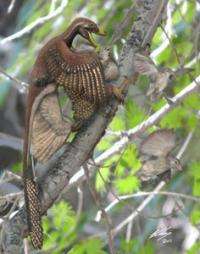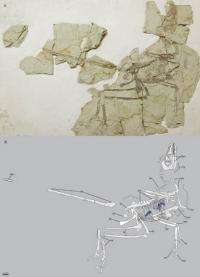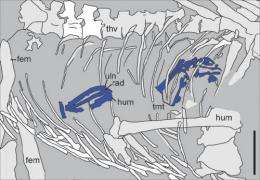November 22, 2011 report
Evidence found of dinosaur that ate birds

(PhysOrg.com) -- When people think of dinosaurs, their thoughts generally turn to the giant guys munching plants, or the ferocious beasts preying on smaller animals. In recent years however, evidence has come to support the notion that modern birds are actually dinosaurs that have survived to live in the present. Now comes evidence that an ancient bird-like dinosaur, a type of raptor, dined on other more modern-like birds. Jingmai O'Connor, Zhonghe Zhou, and Xing Xu, of the Chinese Academy of Sciences, write in their paper published in the Proceedings of the National Academy of Sciences, that a dinosaur fossil they’ve found, called a Microraptor gui, which lived in a period known as the Early Cretaceous Jehol biota, in China, has a partial skeleton of a small bird preserved in its abdomen.
The find has two major storylines. The first is that it’s the first time that a dinosaur has been proven to eat birds. Prior evidence indicated that some dinosaurs likely fed on birds, but till now, no such direct evidence had been found.

The other storyline is the credence that the find gives to the idea that flight evolved as a means for animals to exist in trees rather than as a way for ground based animals to take to the air to hover over other animals whether to find food or as a way to avoid being eaten. The bird found inside the Microraptor was a type of enantiornithines, a group of very small birds that had legs and feet that very clearly identify them as tree dwellers, which meant that in order for the Microraptor to catch and eat it, it must have also spent a lot of time in the trees.

The Microraptor was an interesting creature, with two pairs of wings and a mouth made for swallowing, rather than chewing, and no bigger than a modern pigeon, it must have presented an interesting sight; though pinning down whether it was in fact a traditional type dinosaur that could glide, or a form of bird that flew is still a bit difficult at best. This new evidence showing it fed on not just live birds, but adults means that it was rather good at moving through the air, bolstered no doubt by the long feathers on its arms and legs to help in steering. It appears likely the Microraptor caught the bird in midflight, then swallowed it whole, much the same way modern raptors do.
More information: Additional specimen of Microraptor provides unique evidence of dinosaurs preying on birds, PNAS, Published online before print November 21, 2011, doi: 10.1073/pnas.1117727108
Abstract
Preserved indicators of diet are extremely rare in the fossil record; even more so is unequivocal direct evidence for predator–prey relationships. Here, we report on a unique specimen of the small nonavian theropod Microraptor gui from the Early Cretaceous Jehol biota, China, which has the remains of an adult enantiornithine bird preserved in its abdomen, most likely not scavenged, but captured and consumed by the dinosaur. We provide direct evidence for the dietary preferences of Microraptor and a nonavian dinosaur feeding on a bird. Further, because Jehol enantiornithines were distinctly arboreal, in contrast to their cursorial ornithurine counterparts, this fossil suggests that Microraptor hunted in trees thereby supporting inferences that this taxon was also an arborealist, and provides further support for the arboreality of basal dromaeosaurids.
Journal information: Proceedings of the National Academy of Sciences
© 2011 PhysOrg.com


















